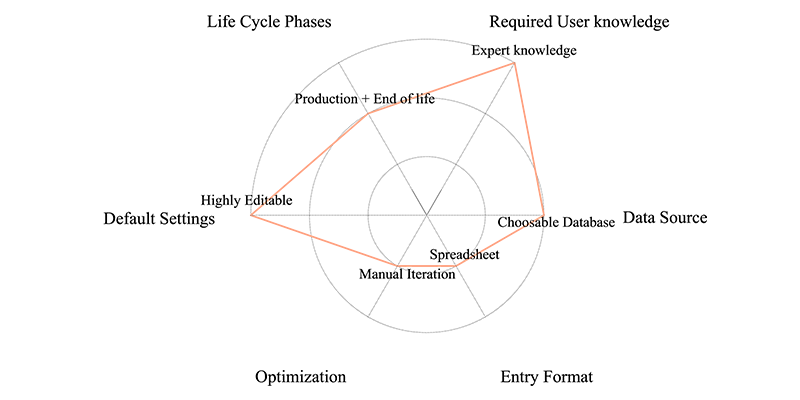Downloads
DOI:
https://doi.org/10.7480/jfde.2019.1.2657Keywords:
Life Cycle Assessment, LCA software programs, façade design, environmental impactAbstract
Façades impact the environmental performance of a building by their passive contribution to operational energy demand and by embodied energy and emissions during each life cycle phase. LCA is a method widely used to quantify the environmental contribution. The use of LCA software programs in façade planning can guide design decisions and contribute to environmental optimisation.
A large amount of LCA software programs have been developed so far, all of which differ in their focus and requirements. This paper aims to address these differences and investigate the capability and suitability of these programs for façade design. It is structured in four sections. The first part introduces LCA in the building and façade design context. The second part introduces categories to understand the different capabilities of LCA software products. Hereafter, eleven products are evaluated based on these categories. The fourth part focuses on the suitability of software products for simple or complex façades.
The study concludes that there are different software choices available for almost every level of user knowledge. While Gabi, Simapro, and Umberto require users to work to a high level of proficiency, software programs like eLCA, CAALA, and 360 Optimi do not require much user knowledge over LCA, but provide a range of other opportunities.
How to Cite
Published
Issue
Section
License
Copyright (c) 2019 Rebecca Bach, Negar Mohtashami, Linda Hildebrand

This work is licensed under a Creative Commons Attribution 4.0 International License.
Authors or their institutions retain copyright to their publications without restrictions.
References
Bach, R., & Hildebrand, L. (2018). Review on tools for assessment of buildings’ environmental performance. In S. Kosanovic, T.
Klein, T. Konstaniou, A. Fikfak, & L. Hildebrand (Eds.), Sustainable and resilient building design - Approaches, methods and tools (Vol. 5). Delft: BK Books.
Beuth. (2006 ). Environmental management - Life cycle assessment - Principles and framework (ISO 14040:2006); German and English version EN ISO 14040:2006 (Vol. 14040). Berlin: Beuth.
Blanchard, & Reppe. (1998). Life Cycle Analysis of a Residential Home in Michigan. Michigan:University of Michigan
Finnveden, G., Hauschild, M. Z., Ekvall, T., Guinée, J., Heijungs, R., Hellweg, S., . . . Suh, S. (2009). Recent developments in Life Cycle Assessment. Journal of Environmental Management, 91, 1-21.
Guardigli, L., Monari, F., & Bragadin, M. A. (2011). Assessing Environmental Impact of Green Buildings through LCA Methods: Acomparison between Reinforced Concrete and Wood Structures in the European Context. Procedia Engineering, 21(0), 1199-1206. doi:http://dx.doi.org/10.1016/j.proeng.2011.11.2131
Guinée, J., Heijungs, R., Huppes, G., Zamagni, A., Masoni, P., Buonamici, R., . . . Rydberg, T. (2011). Life Cycle Assessment: Past, Present, and Future. Environmental Science & Technology, 45(1), 90-96.
Hildebrand, L. (2014). Strategic investment of embodied energy during the architectural planning process. Delft University of Technology, Rotterdam.
Jensen, A. A., Hoffman, L., Møller, B. T., & Schmidt, A. (1997). Life Cycle Assessment-A guide to approaches, experiences and information sources. Retrieved from https://www.eea.europa.eu/publications/GH-07-97-595-EN-C
Klöpffer, W., & Grahl, B. (2009). Wirkungsabschätzung Ökobilanz [LCA)] pp. 195-354. Wiley-VCH Verlag GmbH & Co. KGaA.
Lasvaux, S., Habert, G., Peuportier, B., & Chevalier, J. (2015). Comparison of generic and product-specific Life Cycle Assessment databases: application to construction materials used in building LCA studies. The International Journal of Life Cycle Assessment, 20(11), 1473-1490. doi:10.1007/s11367-015-0938-z
Lüdemann, L., & Feig, K. ( 2014). Comparison of software solutions for Life Cycle Assessment (LCA)– a software ergonomic analysis. Logistics Journal.
Meex, E., Hollberg, A., Knapen, E., Hildebrand, L., & Verbeeck, G. (2018). Requirements for applying LCA-based environmental impact assessment tools in the early stages of building design. Building and Environment, 133, 228-236. doi:https://doi.org/10.1016/j.buildenv.2018.02.016
Nagus. (2006). Environmental labels and declarations –Type III environmental declarations – Principles and procedures (ISO 14025:2006) ISO/TC 207/SC 3 „Environmental Labelling“ (Vol. 14025). Berlin: Normenausschuss Grundlagen des Umweltschutzes (NAGUS) im DIN.
Takano, A., Winter, S., Hughes, M., & Linkosalmi, L. (2014). Comparison of life cycle assessment databases: A case study on building assessment. Building and Environment, 79 (Supplement C), 20-30. doi:https://doi.org/10.1016/j.buildenv.2014.04.025
Villares, M., Isildar, A., Giesen, C. C. V. D. & Guinée, J. B. (2017). Does ex ante application enhance the usefulness of LCA? A case study on an emerging technology for metal recovery from e-waste. International Journal of Life Cycle Assessment; Issue 10.
Young, R. F. (2007). Crossing boundaries in urban ecology: Pathways to sustainable cities (Doctoral thesis). Retrieved from ProQuest Dissertations Thesis database. (UMI No. 327681). For more information see: http://www.library.cornell.edu/resrch/citmanage/apa
